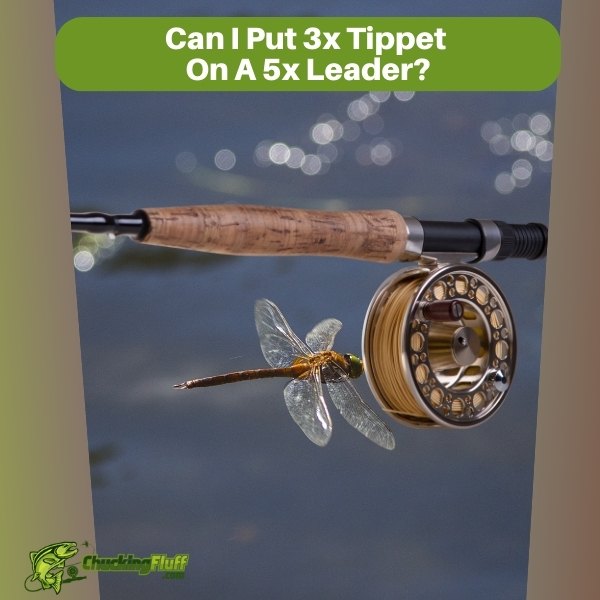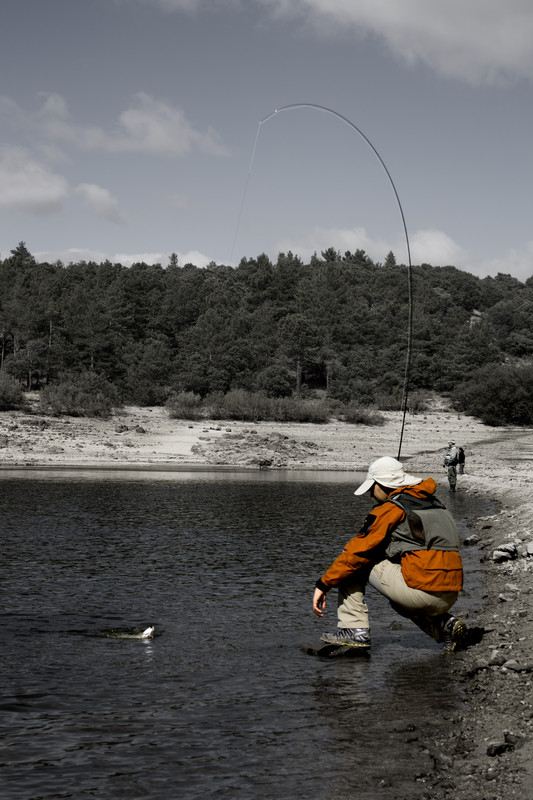| Disclosure: Just to be open and honest the buttons and links you click on in the website will in most cases take you to another website where you can purchase the products I am reviewing. As an Amazon Associate I earn from qualifying purchases. |
Can I Put 3x Tippet On A 5x Leader? Rig Guides

Fly fishing can seem like a world of arcane knowledge, full of strange terminology and seemingly arbitrary rules. One question that often pops up for beginners (and even some seasoned anglers) is about leader and tippet size: Can you put a 3x tippet on a 5x leader? Well, the short answer is: it depends. But to really understand why, let’s dive deeper into the world of leaders and tippets.
Quick Post Navigation
- Understanding Fly Fishing Leader and Tippet
- The X System: Demystifying Leader and Tippet Sizes
- Matching Leader and Tippet: The General Rule
- 3x Tippet on a 5x Leader: Breaking the Rules
- Finding the Sweet Spot: Tips for Choosing the Right Tippet
- Knots to Know: Connecting Leader and Tippet
- Beyond the Basics: Advanced Leader and Tippet Strategies
- Conclusion
- FAQs
- “Check out some of our other Buying Guides”
Understanding Fly Fishing Leader and Tippet
Before we tackle the 3x vs. 5x dilemma, let’s make sure we’re all on the same page about what leaders and tippets actually are.
What is a Leader?
Imagine you’re trying to throw a weightless piece of fluff (your fly) with a thick rope (your fly line). It’s not going to go very far, is it? That’s where the leader comes in. It’s a tapered piece of monofilament or fluorocarbon that connects your fly line to your tippet, acting as a transition between the thick fly line and the thin tippet. This taper helps transfer energy efficiently during your cast, allowing you to present your fly delicately on the water.
What is Tippet?
The tippet is the final, almost invisible link in the chain between your fly rod and your fly. It’s a length of monofilament or fluorocarbon that attaches to the end of your leader and is tied directly to your fly. The tippet’s primary job is to fool the fish, making your fly appear as natural as possible in the water.
The X System: Demystifying Leader and Tippet Sizes
Now, let’s talk about those mysterious “X” numbers you see on leader and tippet spools.
Breaking Down the “X”
The “X” system is a way of classifying fishing line diameter. The higher the X number, the thinner the diameter of the line. So, a 5x leader is thinner than a 3x leader. Think of it like this: imagine a bunch of straws. A 3x straw would be like a big smoothie straw, while a 5x straw would be more like a coffee stirrer.
Diameter and Strength: The Relationship
Generally, the thicker the diameter, the stronger the line. This means a 3x tippet is stronger than a 5x tippet. But, and this is a big but, thicker line is also more visible to fish. It’s a trade-off: strength versus stealth.
Matching Leader and Tippet: The General Rule
The general rule of thumb in fly fishing is to match your tippet size to your leader size or go one size smaller. So, with a 5x leader, you’d typically use a 5x or 6x tippet. This ensures a smooth transition in diameter, minimizing any potential weak points in your setup.
3x Tippet on a 5x Leader: Breaking the Rules
So, back to our original question. Can you use a 3x tippet on a 5x leader? While it goes against the conventional wisdom, there are situations where it might actually make sense.
When It Might Work
Targeting Larger Fish
If you’re going after big, powerful fish like salmon or steelhead, you need a strong tippet that can withstand their aggressive runs and head shakes. In these cases, a 3x tippet might be necessary, even with a 5x leader. You’re essentially sacrificing some stealth for added strength.
Heavy Flies and Windy Conditions
Casting large streamers or fishing in strong winds can put a lot of stress on your leader and tippet. A 3x tippet can provide the extra muscle needed to turn over heavy flies and punch through the wind.
When It’s a No-Go
Spooking Fish
In clear water or when targeting spooky fish like trout, a thick 3x tippet attached to a 5x leader will stick out like a sore thumb. The sudden jump in diameter can create a visible “hinge” that alerts fish to your deception.
Knot Strength and Potential Breakage
Using a much heavier tippet than your leader can create a weak point at the knot connecting the two. The knot might be strong enough to hold the tippet, but the leader itself could break under pressure.
Finding the Sweet Spot: Tips for Choosing the Right Tippet
Ultimately, choosing the right tippet size is about finding the perfect balance between strength, stealth, and presentation. Here are a few factors to consider:
Consider the Water Conditions
Clear water demands finer tippets, while off-colored water allows you to get away with heavier tippets.
Match the Hatch
If the fish are feeding on tiny insects, you’ll need a fine tippet to present your fly delicately. Larger flies can be fished with heavier tippets.
Prioritize Presentation
The most important factor is how your fly behaves in the water. Choose a tippet that allows your fly to drift naturally and entice the fish.
Knots to Know: Connecting Leader and Tippet
Knowing how to tie strong, reliable knots is crucial in fly fishing. Here are two popular knots for connecting your leader and tippet:
The Improved Clinch Knot
This is a versatile knot that’s easy to learn and provides excellent strength. It’s a great all-around knot for most fly fishing situations.
The Orvis Knot
Developed by the Orvis company, this knot is known for its strength and reliability, especially when using heavier tippets.
Beyond the Basics: Advanced Leader and Tippet Strategies
Once you’ve mastered the basics, you can explore more advanced leader and tippet setups to further improve your presentation and success on the water.
Tapered Leaders vs. Furled Leaders
Tapered leaders are the standard in fly fishing, but furled leaders offer a different approach. Made from braided material, furled leaders are incredibly supple and help deliver your fly with exceptional delicacy.
Fluorocarbon vs. Monofilament Tippet
Both fluorocarbon and monofilament have their pros and cons. Fluorocarbon is nearly invisible underwater and sinks faster, while monofilament is more supple and floats higher.
Conclusion
So, can you put a 3x tippet on a 5x leader? Technically, yes. But should you? It depends on the specific fishing situation. Remember, the goal is to present your fly in the most natural way possible while still having enough strength to land the fish. By considering factors like water clarity, fly size, and fish species, you can make an informed decision and choose the right tippet for the job. Don’t be afraid to experiment and find what works best for you. After all, that’s part of the fun of fly fishing!
FAQs
1. What happens if my tippet is too heavy?
If your tippet is too heavy, it will be more visible to fish, potentially spooking them. It can also hinder the natural movement of your fly, making it less appealing.
2. How often should I change my tippet?
It’s a good idea to change your tippet every few hours or after catching a fish. Tippet can become weakened from abrasion, knots, and fighting fish.
3. Can I use fluorocarbon leader with monofilament tippet?
Yes, you can use fluorocarbon leader with monofilament tippet. However, it’s generally recommended to use the same material for both your leader and tippet for optimal performance.
4. What is the best knot for tying on a fly?
There are many great knots for tying on flies, but some popular choices include the improved clinch knot, the Palomar knot, and the uni knot.
5. How do I know if my leader is the right length?
The ideal leader length depends on your fishing situation. A general rule is to use a leader that’s roughly the same length as your rod, but you may need to adjust it based on factors like wind and water conditions.


